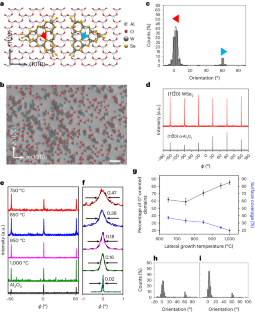ペンシルベニア州立大学の研究者が次世代の2次元半導体を悩ませる「ミラーツイン」欠陥を解決した可能性 Penn State researchers may have solved the “mirror twins” defect plaguing the next generation of 2D semiconductors
2023-08-03 ペンシルベニア州立大学(PennState)
◆研究チームはこの欠陥を解消する方法を見つけ、Nature Nanotechnology誌にその成果を発表しました。この研究結果は、半導体研究に大きな影響を与えるとされ、より広い範囲で応用される可能性があります。
<関連情報>
- https://www.psu.edu/news/materials-research-institute/story/mirror-mirror-who-most-efficient-semiconductor-them-all/
- https://www.nature.com/articles/s41565-023-01456-6#citeas
C面サファイア上のWSe2エピタキシーにおける核生成とドメイン配向制御のためのステップエンジニアリング Step engineering for nucleation and domain orientation control in WSe2 epitaxy on c-plane sapphire
Haoyue Zhu,Nadire Nayir,Tanushree H. Choudhury,Anushka Bansal,Benjamin Huet,Kunyan Zhang,Alexander A. Puretzky,Saiphaneendra Bachu,Krystal York,Thomas V. Mc Knight,Nicholas Trainor,Aaryan Oberoi,Ke Wang,Saptarshi Das,Robert A. Makin,Steven M. Durbin,Shengxi Huang,Nasim Alem,Vincent H. Crespi,Adri C. T. van Duin &Joan M. Redwing
Nature Nanotechnology Published:27 July 2023
DOI:https://doi.org/10.1038/s41565-023-01456-6

Abstract
Epitaxial growth of two-dimensional transition metal dichalcogenides on sapphire has emerged as a promising route to wafer-scale single-crystal films. Steps on the sapphire act as sites for transition metal dichalcogenide nucleation and can impart a preferred domain orientation, resulting in a substantial reduction in mirror twins. Here we demonstrate control of both the nucleation site and unidirectional growth direction of WSe2 on c-plane sapphire by metal–organic chemical vapour deposition. The unidirectional orientation is found to be intimately tied to growth conditions via changes in the sapphire surface chemistry that control the step edge location of WSe2 nucleation, imparting either a 0° or 60° orientation relative to the underlying sapphire lattice. The results provide insight into the role of surface chemistry on transition metal dichalcogenide nucleation and domain alignment and demonstrate the ability to engineer domain orientation over wafer-scale substrates.



